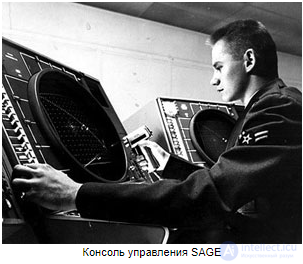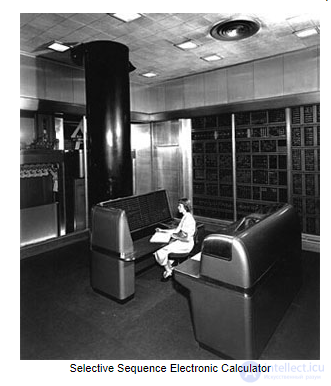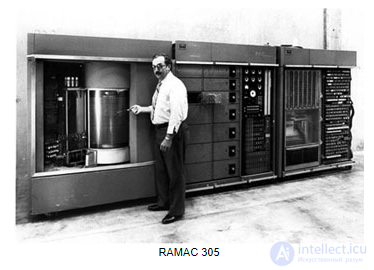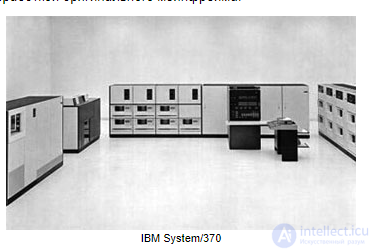Lecture
Time of large mainframes
The beginning of the second half of the last century was of great importance for the modern world. Then the first digital computers began to appear. And IBM took the most active part in their creation. The first American programmable computer was the Mark I (full name Aiken-IBM Automatic Sequence Controlled Calculator Mark I). The most amazing thing was that it was based on the ideas of Charles Babbage, the inventor of the first computer. He didn’t finish it by the way. But in the 19th century it was difficult to do. IBM took advantage of his calculations, shifted them to the technology of the time and saw the light of the Mark I. It was built in 1943, and a year later it was officially put into operation. History "Markov" did not last long. A total of four versions were released, the last of which, the Mark IV, was introduced in 1952.
In the 1950s, IBM received another major order from the government for developing computers for the SAGE (Semi Automatic Ground Environment) system. This is a military system designed to track and intercept potential enemy bombers. This project allowed the blue giant to gain access to research at the Massachusetts Institute of Technology. Then he worked on the first computer, which could easily serve as a prototype of modern systems. So it included a built-in screen, a magnetic memory array, supported digital-analog and analog-digital conversions, had a certain type of computer network, could transmit digital data via a telephone line, supported multiprocessing. In addition, it was possible to connect the so-called "light guns", previously widely used as an alternative to the joystick in consoles and gaming machines. There was even support for the first algebraic computer language.

SAGE Management Console
IBM built 56 computers for the SAGE project. Each cost was $ 30 million at the prices of the 50s. 7000 company employees worked on them, which at that time made up 20% of the entire company staff. In addition to great profits, the blue giant was able to gain invaluable experience, as well as access to military developments. Later, all this was applied in the creation of computers of the next generations.
Ibm System / 360
The next highlight for IBM was the release of the System / 360 computer. It is almost connected with the change of an entire era. Before him, the blue giant produced systems based on vacuum tubes. For example, after the aforementioned Mark I in 1948, the Selective Electronic Calculator (SSEC) was introduced, consisting of 21,400 relays and 12,500 vacuum tubes capable of performing several thousand operations per second.
Selective Sequence Electronic Calculator

In addition to SAGE computers, IBM also worked on other projects for the military. So the Korean War demanded the use of faster means of calculation than a large programmable calculator. Thus, the IBM 701, a fully electronic computer (not from a relay, but from a lamp), which worked 25 times faster than SSEC and at the same time occupied four times less space, was developed. Over the next few years, the modernization of lamp computers continued. For example, the IBM 650 became famous, which produced about 2,000 units.
No less significant for today's computer technology was the invention in 1956 of the device, called the RAMAC 305. It became the prototype of what today wears the abbreviation HDD or just a hard disk. The first hard drive weighed about 900 kilograms, and its capacity was only 5 MB. The main innovation was the use of 50 aluminum round constantly rotating plates, on which information carriers were magnetized elements. This made it possible to provide random access to files, which simultaneously significantly increased the speed of data processing. But the pleasure was not cheap - it cost $ 50,000 at the prices of that time. For 50 years, progress has reduced the cost of one megabyte of data on the HDD from $ 10,000 to $ 0.00013, if we take the average cost of a 1 TB hard drive.
 RAMAC 305
RAMAC 305
The middle of the last century was also noted by the advent of transistors to replace lamps. The first attempts to use these elements of the blue giant began in 1958 with the announcement of the IBM 7070 system. The computers of models 1401 and 1620 appeared a little later. The first was designed to perform various business tasks, and the second was a small scientific computer used to design motorways and bridges. That is, both more compact specialized computers were created, as well as more cumbersome, but with much faster system performance. An example of the former is the 1440 model developed in 1962 for running small and medium-sized businesses, and the latter as an example of the 7094 — in fact, a supercomputer of the early 60s, used in the aerospace industry.
Another brick in the way of creating System / 360 was the creation of terminal systems. Users were allocated a separate monitor and keyboard, which were connected to one central computer. Here you have the prototype of the client / server architecture for a couple with a multi-user operating system.
As is often the case for the most efficient use of innovations, you have to take all previous developments, find their points of contact, and then design a new system using the best aspects of new technologies. The IBM System / 360, introduced in 1964, became such a computer.
It is somewhat reminiscent of modern computers, which, if necessary, can be updated and to which you can connect various external devices. A new range of peripheral devices was developed for System / 360 in the amount of 40 pieces. These included IBM 2311 and IBM 2314 hard drives, IBM 2401 and 2405 tape drives, punch card equipment, text recognition devices, and various communication interfaces.
Another important innovation is unlimited virtual space. Before System / 360, such things cost a tidy sum. Of course, for this innovation we had to reprogram something, but the result was worth it.
Above we wrote about specialized computers for science, for business. Agree, this is somewhat inconvenient for both the user and the developer. System / 360 has become a universal system that can be used for most tasks. And now it could be used by a much larger number of people - simultaneous connection of up to 248 terminals was supported.
70s and IBM era System / 370
The next decade in the history of IBM was not so revolutionary, but several important events took place. The 1970s opened with the release of System / 370. After several modifications of the System / 360, this system has become more complex and serious processing of the original mainframe.

IBM System / 370
The most important innovation of the System / 370 is the support of virtual memory, that is, in fact, it is an expansion of the RAM by constant. Today this principle is actively applied in modern operating systems of Windows and Unix families. However, in the first versions of System / 370, its support was not included. Widely available virtual memory IBM made in 1972 with the introduction of the System / 370 Advanced Function.
Of course, this list of innovations does not end there. The System / 370 series of mainframes supported 31-bit addressing instead of 24-bit. By default, dual-processor support was maintained, and there was compatibility with 128-bit fractional arithmetic. Another important feature of the System / 370 is full backward compatibility with System / 360. Software course.
The next mainframe of the company was System / 390 (or S / 390), introduced in 1990. It was a 32-bit system, although it retained compatibility with 24-bit System / 360 addressing and 31-bit System / 370 addressing. In 1994, it became possible to combine several System / 390 mainframes into one cluster. This technology is called Parallel Sysplex.
After System / 390, IBM introduced the z / Architecture. Its main innovation is support for 64-bit address space. At the same time, new mainframes with a large number of processors were released (first 32, then 54). The appearance of the z / Architecture falls on the year 2000, that is, this development is completely new. Today, within its framework, System z9 and System z10 are available, which continue to enjoy steady popularity. And what's more, they continue to maintain backward compatibility with System / 360 and later mainframes, which is a record of its kind.
At the same time we close the topic of large mainframes, for which we told about their history up to the present day.
Meanwhile, IBM has matured a conflict with the authorities. It was preceded by the departure of the main competitors of the blue giant from the market of large computer systems. In particular, NCR and Honeywall decided to focus on more profitable niche market segments. And System / 360 was so successful that no one could compete with it. As a result, IBM has effectively become a monopolist in the mainframe market.
All this January 19, 1969 flowed into the trial. Quite expectedly, the IBM was accused of violating Section 2 of the Sherman Act, which provides for responsibility for monopolizing or attempting to monopolize the market for electronic computer systems, especially systems intended for business use. The trial lasted until 1983 and ended for IBM in that it seriously revised its view of doing business.
It is not excluded that the antitrust proceedings affected the "FutureSystems project" project, in which it was intended to once again combine all the knowledge and experience of past projects (just like during System / 360) and create a new type of computer that once again surpasses all previously made system. Work on it was carried out between 1971 and 1975. The reasons for its closure are called economic inexpediency - according to analysts, he would not have fought off as happened with System / 360. Or maybe IBM really decided to restrain the horses a bit due to ongoing litigation.
The same decade is attributed to another very important event in the computer world, although it happened in 1969. IBM began selling software manufacturing services and the software itself separate from the hardware component. Today, this is not surprising to anyone - even the current generation of domestic users of pirated software has become accustomed to paying for programs. But then on the heads of the blue giant began to pour multiple complaints, criticism of the press, and at the same time and lawsuits. As a result, IBM began to sell separately only application applications, while software to monitor computer operation (System ControlProgramming), in fact, the operating system, was free.
And at the very beginning of the 80s, a certain Bill Gates from Microsoft proved that the operating system may be paid.
Comments
To leave a comment
History of computer technology and IT technology
Terms: History of computer technology and IT technology